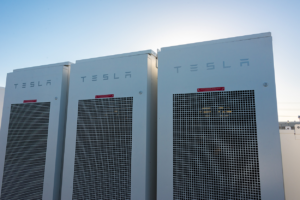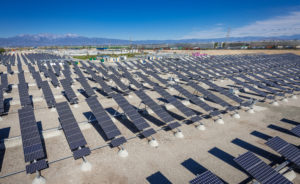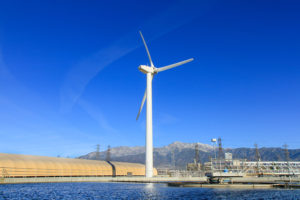Pretreatment and Source Control
No. Please see the current ordinances for more details.
Any Person/User whose industrial processes produce wastewater requires a wastewater discharge permit. If the industry is a zero discharger (produces no wastewater), annual certification of compliance as zero discharger is required.
CU for the Etiwanda Wastewater Line (EWL) and Inland Empire Brine Line (IEBL) systems is defined as 15 instantaneous gallons per minute. The Person/User must acquire enough CU to accommodate their peak flows rounded up to the nearest multiple of 15. The cost for each CU is set in the Wastewater Disposal Rates Resolutions.
CU for the Non-Reclaimable Wastewater System (North NRWS) is defined by the following equation:

Where gpd = gallons per day; ppd = pounds per day
The Person/User must acquire enough NRWS CU to meet their wastewater discharge. For the NRWSCU, the Person/User can either purchase upfront or lease annually. The cost for each NRWS CU is set in the Wastewater Disposal Rates Resolutions.
In the Agency’s service area, Total Dissolved Solids (TDS) is used primarily to determine the sewerage system that can receive the industrial wastewater. Regional Permit if TDS is less than or equal to 550 mg/L. All others, Non-Reclaimable Wastewater (NRW system) permit. Please see the Permit Application flowchart for guidance.
Before applying for an industrial wastewater discharge permit, the Person/User must obtain the wastewater discharge right in the form of Capacity Units (CU). The CU are different for each system.
Please direct questions or comments concerning the use of the NRWS or Regional Sewage System to Pretreatment & Source Control (909) 993-1600.
Visit the WATER SOURCES PRETREATMENT & SOURCE CONTROL page. Permit types are based on TDS limits, location, and amount of discharge.
Please see the Permit Application Flowchart to determine the appropriate path to obtain an industrial wastewater discharge permit.
Water Resource Management
IEUA has enhanced the capabilities of the Groundwater Recharge Program to help replenish the area’s underground aquifers. These recharge sites enhance the reliability of the local groundwater supply for a growing population. Located throughout IEUA’s service area are 19 recharge sites designed to capture runoff from storms, imported water from the State Water Project, and/or high quality recycled water from IEUA’s distribution system.
IEUA is a member of the Metropolitan Water District of Southern California (MWD) and thus acts as a supplemental water provider. One-fourth of the water used in the region is imported from MWD through the State Water Project.
IEUA implements an effective pretreatment and cost effective source control program, manages activities to enhance recycled water quality, protects capital assets through on-going condition assessment and collection system maintenance, and assures compliance with The National Pollutant Discharge Elimination System (NPDES) requirements.
IEUA seeks to support maximizing the beneficial reuse of recycled water to enhance reliability and to reduce dependence on imported water. IEUA began selling recycled water in the 1970s as a low cost alternative to potable water for large irrigation customers. Over the past 10 years, IEUA and its local water providers have invested in an aggressive program to expand delivery of high quality recycled water to its service area as a reliable irrigation and industrial water source that has improved the sustainability of the region’s water supply.
The Chino Basin Groundwater Aquifer is a major water supply source for the communities in the Santa Ana Watershed. In IEUA’s service area alone, Chino Basin accounts for up to 40% of the drinking water supply. As a result of development, natural groundwater recharge that would occur during rain events has diminished. It is estimated that today, approximately 30,000 AF per year–or the equivalent of half of IEUA’s imported water supplies from the State Water Project–are lost to stormwater runoff. To counteract this, IEUA is working with its partners in the Chino Basin Groundwater Recharge programs and local agencies to capture and store as much stormwater as possible. This helps protect local water supplies and the environment by decreasing polluted runoff and reducing the risk of flooding.
Recycled Water
Yes, tertiary treated recycled water is perfectly safe for crop irrigation.
Yes, it is perfectly safe to consume fish that swim in recycled water. Prado Lake, a popular fishing spot in the Chino area, uses IEUA’s recycled water.
Recycled water and potable water lines are kept separate. All pipes to distribute recycled water are colored purple and labeled with the words “Recycled Water – Do Not Drink” for easy recognition. Each site using recycled water must post signs to notify the public of its use.
Water treatment technology has been developed to mimic nature’s cleansing process. Prior to its use, recycled water undergoes four stages of purification to produce a high-quality water that meets or exceeds standards making it safe to reuse. The purification at a water recycling plant is an accelerated and controlled version of what occurs in nature, and can be as good as or even better than the natural process.
In the primary stage of purification, the wastewater entering a water recycling plant is collected in large tanks where settled and float-able materials are removed for further treatment and disposal. The wastewater, which still contains dissolved and upended organic material, continues to the next stage of processing.
In the secondary stage of purification, the wastewater from the primary process is further treated in aeration tanks which contain naturally occurring microbes and enzymes that consume the dissolved and organic material that remains suspended in the water. Air is bubbled through the tanks to supply the microbes with oxygen. Following treatment, settling is used to separate those microbes from the water being treated. This highly treated water is then sent to the final process at the water recycling facility.
In the tertiary stage of purification, filtration and disinfection are conducted. Any remaining suspended solids are removed using specialized granular material or membrane filters. Similar to water plants that produce drinking water, the water in this process is fully disinfected to kill any remaining organisms in this final step of the water recycling process. Following the highly regulated, controlled, and complex purification process, the recycled water is distributed using its own dedicated pipeline system for a wide variety of reuse applications, including landscape irrigation, industrial, manufacturing and groundwater recharge.
The fourth stage occurs in the soil during recharge following purification at the water recycling plant.
Yes. Recycled water is cost-effective because large amounts of recycled water can be used at a relatively modest cost. Because of economies of scale, a regional water recycling project is more cost-effective than several smaller projects serving the same service area. As reliability and availability of existing local and imported water supplies decreases and the marginal cost of producing additional water increases, water recycling becomes a more cost-effective alternative for supplementing the exiting water supplies.
Yes, recycled water is safe. Recycled water is a highly treated, filtered and disinfected product that meets criteria established by the California Department of Health Services. Recycled water is appropriate for all human contact, except drinking.
No. California’s first recycling project began in 1929 when the city of Pomona started using treated municipal wastewater for landscape irrigation.
Acre Foot (AF) – Measurement for water qualing 325,851 gallons, or enough water to cover a football field to a depth of one foot. An acre foot of water is enough to supply the water needs of two households for one year.
Recycled Water – Wastewater that, as a result of appropriate treatment, is suitable for subsequent beneficial use.
Potable Water – Water that is suitable for drinking.
Wastewater – Water and wastes discharged from homes, businesses, and industry to the sewer system.
Recycled water is wastewater that has been purified through a high level of treatment. Recycled Water is treated to strict standards set by the California Department of Health Services and is constantly monitored by local, State, and Federal Regulatory agencies to ensure it continuously meets those standards. In fact, all water on earth is in some way recycled. Mother Nature has been recycling water and wastewater through a natural cleansing process of purification. Modern wastewater treatment technology essentially speeds up this natural process through sedimentation, organic consumption, natural filtration and disinfection.
IEUA conducts rail, weekly, quarterly, and annual sampling of recycled water based on a sampling schedule as require by regulatory permits, and reports the results to the California Department of Public Health and Regional Water Quality Control Board. Click here to view reports on Recycled Water.
To protect the environment and meet local water needs. Water recycling is not a luxury but a necessity as water is a precious natural resource that is in short supply in semi-arid Southern California. There is no new water so recycled water reduces dependence on our limited water supplies helping to drouth-proof the rapidly growing Inland Empire. 100 percent of the IEUA’s recycled water is reused. Recycled water provides a safe, cost-effective and reliable supply of high quality water.
Water is in short supply in California. A great deal of the State’s developed water supply is transported hundreds of miles from the water-rich area of the north for use in the more populated southern cities. This long-term water import dependency, coupled with all the recent droughts, makes future water supply a vital concern to residents. The need for water is expected to grow, driven by increasing population, need for protection of the San Joaquin Sacramento River Delta, and greater industrialization. Increased conservation efforts will slow but not stop this growth in demand. THE ANSWER IS WATER RECYCLING.
Environmental Stewardship
The Park consists of 22 acres that are landscaped with a wide variety of climate appropriate trees and grass and features a state-of-the-art irrigation management system. Key components of the park are the community education elements about the value of conservation and the importance of wetlands in the structure of our environment which will weave throughout the site. The park serves as a demonstration site for the community on how to improve water supply, stormwater treatment, and water use efficiency. Additional park features include wetlands and riparian habitat, trails, sampling stations, picnic areas, visitor’s center, parking, bridges, and an amphitheater.
Learn more about the Chino Creek Wetlands and Educational Park
IEUA developed a partnership with the Los Angeles County Sanitation Districts to create the Inland Empire Regional Composting Authority (IERCA). The IERCA determined that recycling biosolids into a high quality compost product, in a fully enclosed, local facility was the best approach to overcoming the challenges of biosolids management. The Inland Empire Regional Composting Facility (IERCF) located in Rancho Cucamonga, is the nation’s largest fully enclosed composting facility. In operation since 2007, the IERCF is an excellent example of IEUA’s ability to provide a regional sustainable solution to biosolids management.
The Inland Empire Garden Friendly (IEGF) Program is a regional program sponsored by IEUA and various other entities. More than 60 percent of residential water usage in the Inland Empire is used on outdoor irrigation. Planting climate-appropriate species can help lower water usage.
Many climate-appropriate plants also save time, as they require less maintenance than other species that require higher amounts of water to thrive. The IEGF Program focuses on the importance of climate-appropriate plants and education. Offering a variety of plant sales throughout the Inland Empire and educational workshops, the community can take part in water-saving efforts.
LEED™ Headquarters: The Agency’s Board of Directors approved the use of LEED™ design criteria for the Agency headquarters located in the city of Chino. Using tilt-up construction, the Agency was the first and largest public building to receive the Platinum rating in 2003 for the United States Green Building Council’s Leadership in Energy and Environmental Design (LEED™). The Headquarters showcases how an integrated, sustainably designed building can create a better environment, conserve energy, improve productivity, and contribute to the restoration of native landscapes.
Learn more about the LEED™ Credit Points.
The No Drugs Down the Drain program is a public outreach program to alert California residents living in specific regions about the problems associated with flushing unused, unwanted, and expired medications down the toilet or drain and to provide them with other, safe and proper disposal choices. Please remember that it is never acceptable for anyone to flush medications down the drain.
For more information visit the No Drugs Down the Drain website or visit IEUA’s webpage on Pretreatment and Source Control.
IEUA seeks to support maximizing the beneficial reuse of recycled water to enhance reliability and to reduce dependence on imported water. IEUA began selling recycled water in the 1970s as a low cost alternative to potable water for large irrigation customers. Over the past 10 years, IEUA and its local water providers have invested in an aggressive program to expand delivery of high quality recycled water to its service area as a reliable irrigation and industrial water source that has improved the sustainability of the region’s water supply.
The Inland Empire Utilities Agency (IEUA) has achieved a Gold rated Sustainable Water Management (SWM) Profile by the Water Foundation. The SWM Profile assesses a water supply agency, the areas it relies on for water supply and areas where it supplies water. IEUA earned a truly exceptional Gold rating because it provides leadership and support for the planning, implementation and collaboration needed for sustainable water supply management for its member agencies, regional partners and the people who share dependence on common water supplies. These efforts, especially in recycled water, groundwater cleanup and recharge and water efficiency, have accomplished more stable and sufficient local water supplies and improved water quality.
IEUA seeks to promote water-use efficiency through public education to enhance water supplies within the region and exceed state goals for reduction in per capita water use within the Agency’s service area. Smart water planning starts with water conservation. Every gallon of water saved within the Chino Basin translates into reduced demand for expensive imported water supplies. By being more efficient, our community will increase the reliability of our existing water supplies and reduce the cost of imported water purchases. IEUA’s goal is to save over 100,000 acre-feet of water over through conservation activities by 2040- that’s about 40% reduction in demand. In order to help the community reach their water savings goal, IEUA offers a variety of rebates available to both residential and commercial customers.
Renewable Energy
 IEUA entered into a partnership with Advanced Microgrid Solutions (AMS) to install, operate and maintain 4 MW of battery storage at six IEUA facilities (four treatment plants and two pump stations).
IEUA entered into a partnership with Advanced Microgrid Solutions (AMS) to install, operate and maintain 4 MW of battery storage at six IEUA facilities (four treatment plants and two pump stations).
The batteries, supplied by Tesla, will reduce IEUA’s demand for power during peak periods, saving the Agency approximately $220,000 annually in electricity costs. The project will charge the batteries at night when power costs are at their lowest and use the batteries during the day when grid demand is highest and costs are exponentially higher.
These battery storage systems will integrate IEUA’s renewable installations and give IEUA a greater ability to cost-effectively meet the Agency’s demand and optimize the delivery of self-generated electricity. Furthermore, the batteries can potentially act as a resource for the utility to shed grid load during periods of high demand.

In 2008, IEUA installed 3.5 MW of solar power at its water recycling facilities and the Inland Empire Regional Composting Facility. The 3.5 MW of solar energy, enough to power approximately 600 homes for one year. To view real-time energy generated by IEUA’s solar installation, click here (net capacity 3.5 MW; gross capacity 3.6 MW).

A 1 MW wind turbine is installed at the northern Regional Water Recycling Plant No. 4. The wind turbine stands 180 feet high and has three blades that span 100 feet in length and provides a portion of the electricity needed at the plant.
